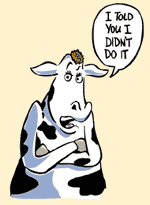|
The history of
Fire Prevention Week has its roots in the Great Chicago Fire, which began on
October 8 but continued into and did most damage on October 9, 1871. In just 27
hours, this tragic conflagration killed more than 250 people, left 100,000
homeless, destroyed more than 17,400 structures and burned more than 2,000
acres. While the origin of the fire has never been determined, there has been
much speculation over how it began.
According to popular legend, the fire broke out after a cow – belonging
to Mrs. Catherine O'Leary – kicked over a lamp, setting first the barn, then
the whole city on fire. Chances are you've heard some version of this story
yourself; people have been blaming the Great Chicago Fire on the cow and Mrs.
O'Leary, for more than 130 years. But important research by Chicago historian
Robert Cromie has helped to debunk this version of events.
An Old Cow's Tale
 Like
any good story, the "case of the cow" has some truth to it. The great
fire almost certainly started near the barn where Mrs. O'Leary kept her five
milking cows. But there is no proof that O'Leary was in the barn when the fire
broke out – or that a jumpy cow sparked the blaze. Mrs. O'Leary herself swore
that she'd been in bed early that night, and that the cows were also tucked in
for the evening. Like
any good story, the "case of the cow" has some truth to it. The great
fire almost certainly started near the barn where Mrs. O'Leary kept her five
milking cows. But there is no proof that O'Leary was in the barn when the fire
broke out – or that a jumpy cow sparked the blaze. Mrs. O'Leary herself swore
that she'd been in bed early that night, and that the cows were also tucked in
for the evening.
But if a cow wasn't to blame for the huge fire, who was? Over the years,
journalists and historians have offered plenty of theories. Some blamed the
blaze on a couple of neighborhood boys who were near the barn sneaking
cigarettes. Others believed that a neighbor of the O'Leary's may have started
the fire. Some people have speculated that a fiery meteorite may have fallen to
earth on October 8, starting several fires that day – in Michigan and
Wisconsin, as well as in Chicago.


|